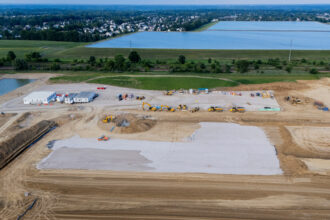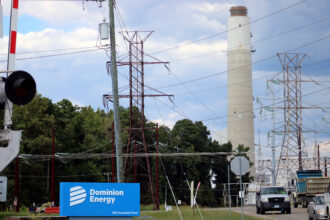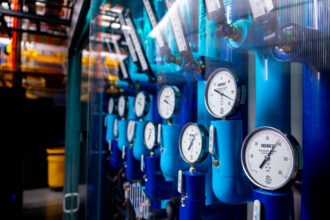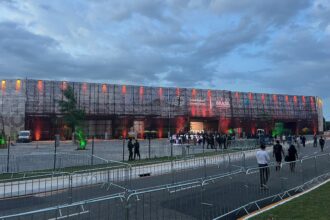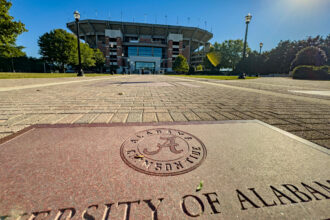At the corner of 48th Street and Santa Fe Avenue in industrial Vernon, a three-story building looms large among rumbling factories and warehouses. Long, vertical, tinted windows with green outlines punctuate the two-acre structure’s grey and white facade–all in the service of keeping its tenants cool inside. Its tenants aren’t people, but giant servers, storage drives and networking equipment.
Data centers like Prime Data Center in Vernon have been popping up all over the country, fueled by the tech industry’s insatiable need for cloud computing services that allow them to host and process enormous amounts of information. Los Angeles has been no exception. There are 71 data centers scattered across the county, according to the industry site Data Center Map. Vernon, a 5-square-mile chunk of southeast Los Angeles, already houses at least one and is about to get another, according to Vernon officials.
Prime Data Center, a company headquartered in Dallas, opened and leased its servers to two artificial intelligence companies in November, according to their website. The Goodman Group, which develops and manages logistics and data centers, is slated to open another data center by June 2026, according to the company’s press release. A staff report by the city’s treasury department also references a Coresight data center, but it’s unclear whether a third data center is also in the works–city officials acknowledged only two.
Around the country, residents and local officials have struggled with whether to welcome data centers, expressing concerns about the volume of water and electricity that AI data centers use. Data centers across the U.S. directly consume roughly 17.5 billion gallons of water and represent 4.4% of total electricity consumption, according to a report by Lawrence Berkeley National Laboratory.
But Vernon has seemingly welcomed the new businesses.
“Residents and businesses benefit from the new and stable load growth that data centers like Prime bring, enabling VPU [Vernon Public Utilities] to more accurately manage its electrical distribution system and the procurement of California-mandated renewable energy,” Brian Saeiki, Vernon’s city administrator, said in a statement to LA Public Press.
Prime Data Center has not responded to multiple requests for comment.
With a population of only 222 residents, making it the second least populous city in the state, according to the latest Census data, Vernon mostly houses industry and hasn’t had a strong organized community response to the plant, unlike what has been reported in other cities.
The Sierra Club, which has vocally opposed data centers nationwide, declined an interview for this story. While a spokesperson said the group didn’t have enough insight on this specific data center to weigh in, the organization did share the following comment:
“In general, data centers have an enormous impact on the environment and energy bills and should be regulated across California to protect local communities, not big tech profits,” Julia Dowell, Sierra Club’s California senior campaign organizer said in a statement to LA Public Press.
“The greater LA area should be worried about whether these data centers will keep polluting fossil fuel plants open, which will contribute to local air pollution and hurt climate progress,” Dowell added.
When LA Public Press visited the neighborhood around Prime Data Center, residents didn’t seem to know it existed.
The building is visible from Martha Macias’s front porch. She said she saw it being built but had no idea what it was. Now that she knows what it is, she said she isn’t too concerned, but she said she wants the city to prioritize building more housing instead of bringing in more businesses.
“We need more housing,” Macias said in Spanish.
On a gloomy Friday afternoon, three workers from a nearby business ate lunch in the back of a car in a parking lot a few feet away from the data center. The workers, who declined to give their names, said they had no idea that the building was a data center, much less did they know what a data center was for. They said they had figured it was just another clothing factory.
When LA Public Press shared with the three workers that another data center was being built on the 5.6-acre site that was previously home to the Farmer John slaughterhouse, their eyes opened wide in shock.
Jasmin Bravo, who is in her early twenties and has lived in Vernon for most of her life, lives about 500 feet from the structure. She is used to the humming and fumes spilling from nearby factories, she said, and has “no big concerns” about the data center. She said the city has done a good job at providing her with information about the data center and how it can bring revenue for the city.
What Are Data Centers?
If you have ever used ChatGPT to write an essay or indulged in TikTok’s latest trend using Google Gemini to create AI-images of yourself with a loved one, you have relied on data centers that serve AI companies. The AI market is projected to quadruple globally to $4.8 trillion by 2033, according to a UN Trade and Development report. As demand grows, AI tools need physical infrastructure to store, process, and transmit this data, and that’s where data centers come in.
From the outside, a data center can look like a regular building, but on the inside, it houses “large numbers of computer servers and supporting equipment like networking, storage, cooling, power, backup,” said Yuanyuan Shi, an assistant professor at UC San Diego’s department of electrical and computer engineering.
AI data centers, in particular, are “very electricity hungry,” Shi said. Training an AI model to learn from huge amounts of data requires additional computing power. Asking ChatGPT to compose an answer uses nearly 10 times as much electricity as a traditional Google search, according to a Goldman Sachs report.
When running AI model training or inference there’s a lot of fluctuation of power very suddenly. Power usage can drop from 100% to 30 or 40% in seconds, Shi said, which can disrupt the power grid and impact power quality for local residents or businesses. Data from more than 700,000 homes within 50 miles of data centers reveal that there’s a strong correlation between data centers and declining power quality, according to a Bloomberg analysis.
This story is funded by readers like you.
Our nonprofit newsroom provides award-winning climate coverage free of charge and advertising. We rely on donations from readers like you to keep going. Please donate now to support our work.
Donate NowJust like when you’re running dozens of open tabs on your computer and it starts overheating and its fan goes off, data centers use water or cooling systems to keep the equipment from overheating, which also make these data centers “very water hungry,” according to Shi. Google’s data centers alone consumed an estimated 12.7 billion liters of fresh water in 2021 to keep their servers cool.
But Vernon officials said that won’t be an issue locally.
“The project is not expected to have any significant impact on electricity or water availability for Vernon residents or businesses,” Saeki said.
The city of Vernon operates its own publicly owned utility, Vernon Public Utilities, along with its own power-generating plant. Compared to other utility jurisdictions, Vernon’s Public Utilities has the available power to support the data center’s electrical needs, according to Saeki. No additional power or water purchases are needed to support the new electrical load and water demand, costs that, in other utility jurisdictions, often lead to rate increases, Saeki added.
Prime Data Center has an on-site substation, according to its website, which assists in efficiently bringing large amounts of power to the many different components and equipment within the data center. The substation helps prevent power grid fluctuations and allows for more stable power distribution, Shi said.
“I think that is a very good thing because that means this data center is likely not to cause a lot of issues for the local residents,” Shi said.
The center also uses air-cooled technology rather than water-cooled systems, minimizing water use, according to Saeki.
Around the Country, Data Centers Have Seen Opposition
National opposition to data center construction is largely motivated by local concerns, including higher utility bills, water consumption, noise and impact on property values and green space, according to the Data Center Watch, a group funded by AI firm 10a Labs that tracks local opposition. The opposition also seems to be bipartisan. More than half, or 55%, of Republican elected leaders have publicly opposed data center projects, often citing concerns regarding tax abatement, while 45%of Democratic leaders have opposed mainly due to environmental concerns, according to Data Center Watch analysis.
“$64 billion of data center projects have been blocked or delayed amid local opposition,” according to Data Center Watch.
This month, California legislators passed Assembly Bill 93, which would require data center operators to report their water use annually. If signed by Gov. Gavin Newsom, drought-prone California would be among the first states to require water disclosure as the country experiences a data center construction boom, according to the LA Times. Newsom has until Oct. 12 to sign or veto the bill.
About This Story
Perhaps you noticed: This story, like all the news we publish, is free to read. That’s because Inside Climate News is a 501c3 nonprofit organization. We do not charge a subscription fee, lock our news behind a paywall, or clutter our website with ads. We make our news on climate and the environment freely available to you and anyone who wants it.
That’s not all. We also share our news for free with scores of other media organizations around the country. Many of them can’t afford to do environmental journalism of their own. We’ve built bureaus from coast to coast to report local stories, collaborate with local newsrooms and co-publish articles so that this vital work is shared as widely as possible.
Two of us launched ICN in 2007. Six years later we earned a Pulitzer Prize for National Reporting, and now we run the oldest and largest dedicated climate newsroom in the nation. We tell the story in all its complexity. We hold polluters accountable. We expose environmental injustice. We debunk misinformation. We scrutinize solutions and inspire action.
Donations from readers like you fund every aspect of what we do. If you don’t already, will you support our ongoing work, our reporting on the biggest crisis facing our planet, and help us reach even more readers in more places?
Please take a moment to make a tax-deductible donation. Every one of them makes a difference.
Thank you,





